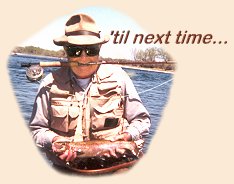
| ||
|
August 18th, 2003
|
|
Q. From Tie 1 On: I am interested in studying aquatic insect ecology "up close and personal." To accomplish this, I'm contemplating an aquarium project. Most freshwater aquaria references don't address trout environments. Any tips, experience or specific references I could turn to? Thanks.
A.
A noble project, but I hope you have plenty of
money, resources, and facilities to undertake
such a project. I say this because it is very
difficult to culture most aquatic insects under
aquarium conditions. This is a generality, because
I don't know which specific insects you are
talking about (stream insects, lake insects).
Environmental characteristics such as physical
(temperature, flow-rate, substratum type, light),
chemical (dissolved oxygen, pH, nutrients), and
nutritional (seston, algae, invertebrates, organic
matter) requirements differ considerably from
species to species and all have to be maintained
properly if you expect to raise a particular species
through its life cycle. For instance, if you are
interested in studying a grazing insect, then you
will have to furnish the proper substratum for it
to live on, sufficient light to insure that its
algal food base will grow on the substratum, the
correct types and amounts of nutrients to be sure
the algae will grow, and the temperature for all
of this to work. The easiest way to solve much
of this is to have a flow-through system using a
natural stream for a water source. That usually
provides everything except the substratum to your
system.
|
| If you would like to comment on this or any other article please feel free to post your views on the FAOL Bulletin Board! |
[ HOME ]
[ Search ] [ Contact FAOL ] [ Media Kit ]
 The 'Stream Doctor' is a retired professional stream ecologist and
author, now living in the West and spending way too much time
fly-fishing. You are invited to submit questions relating to
anything stream related directly to him for use in this Q & A Feature
at
The 'Stream Doctor' is a retired professional stream ecologist and
author, now living in the West and spending way too much time
fly-fishing. You are invited to submit questions relating to
anything stream related directly to him for use in this Q & A Feature
at